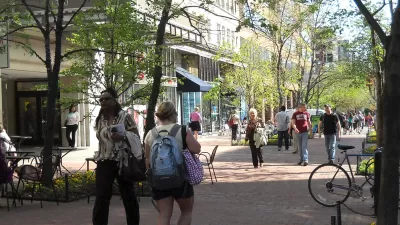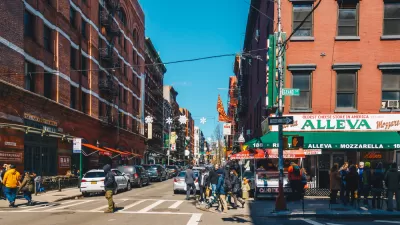Millennials and an aging Baby Boomer population have put a premium on "the hottest trend in real estate": walkability.

Via the Huffington Post, F. Kaid Benfield of PlaceMakers writes that the most sought after amenity for renters and buyers is now 'walkability'. Access to services, shops, restaurants and transportation is now a huge consideration for millennials and baby boomers, whether they prefer to live in the suburbs or in the urban core. Benfield cites a nationwide survey by the National Association of Realtors and Portland State University that found 'walkability' as an important factor in the selection of where people live.
Across all generations, the Realtors/Portland State survey found that an overwhelming majority of respondents - 79 percent - believe it to be very or somewhat important, in choosing a home, to be "within an easy walk of other places and things in the community." It also found that people who now live in such neighborhoods are especially satisfied with the quality of life in their communities. Fifty-four percent of those respondents who agreed with the statement "there are lots of places to walk nearby, such as shops, cafes, and restaurants" reported being very satisfied with the quality of life in their communities; only 41 percent of all respondents reported being very satisfied.
Benfield notes that while most cities across the United States have areas that can be considered 'walkable', there aren’t enough to meet demand.
And, because their supply is limited, prices for walkable locations are sky-high. Research has shown that each one-point increase in a home's Walk Score (a 100-point scale measuring an address's accessibility to walkable destinations) is associated with a $700 to $3000 increase in its value compared to less walkable homes of comparable size.
So what can be done to create more walkable areas in our cities and suburbs? Banfield offers a few good solutions, including the implementation of form-based codes and a focus on LEED for Neighborhood Development when updating that existing zoning codes.
FULL STORY: We Want More Walkable Neighborhoods -- but Can Our Communities Deliver?

Planetizen Federal Action Tracker
A weekly monitor of how Trump’s orders and actions are impacting planners and planning in America.

Congressman Proposes Bill to Rename DC Metro “Trump Train”
The Make Autorail Great Again Act would withhold federal funding to the system until the Washington Metropolitan Area Transit Authority (WMATA), rebrands as the Washington Metropolitan Authority for Greater Access (WMAGA).

The Simple Legislative Tool Transforming Vacant Downtowns
In California, Michigan and Georgia, an easy win is bringing dollars — and delight — back to city centers.

The States Losing Rural Delivery Rooms at an Alarming Pace
In some states, as few as 9% of rural hospitals still deliver babies. As a result, rising pre-term births, no adequate pre-term care and "harrowing" close calls are a growing reality.

The Small South Asian Republic Going all in on EVs
Thanks to one simple policy change less than five years ago, 65% of new cars in this Himalayan country are now electric.

DC Backpedals on Bike Lane Protection, Swaps Barriers for Paint
Citing aesthetic concerns, the city is removing the concrete barriers and flexposts that once separated Arizona Avenue cyclists from motor vehicles.
Urban Design for Planners 1: Software Tools
This six-course series explores essential urban design concepts using open source software and equips planners with the tools they need to participate fully in the urban design process.
Planning for Universal Design
Learn the tools for implementing Universal Design in planning regulations.
Smith Gee Studio
City of Charlotte
City of Camden Redevelopment Agency
City of Astoria
Transportation Research & Education Center (TREC) at Portland State University
US High Speed Rail Association
City of Camden Redevelopment Agency
Municipality of Princeton (NJ)



























